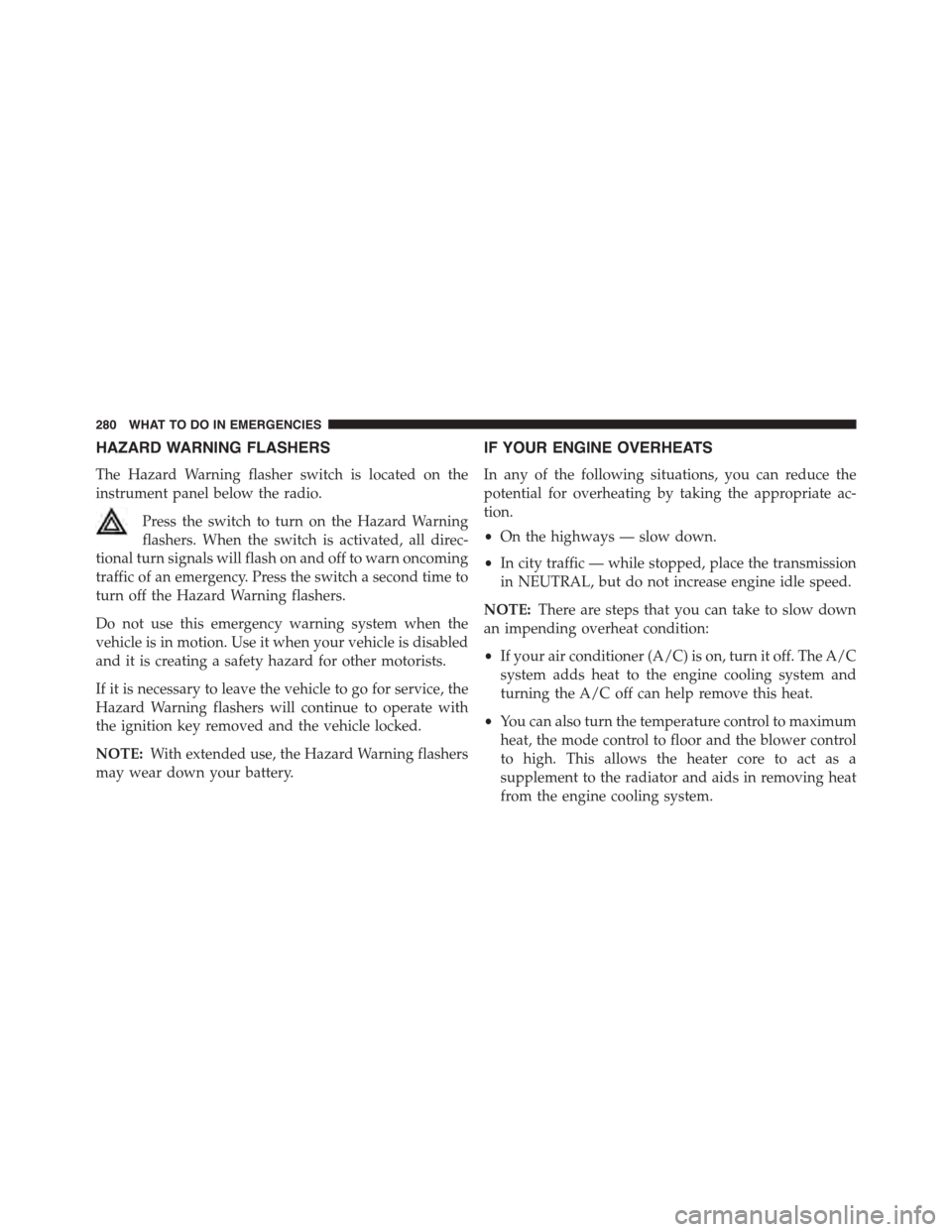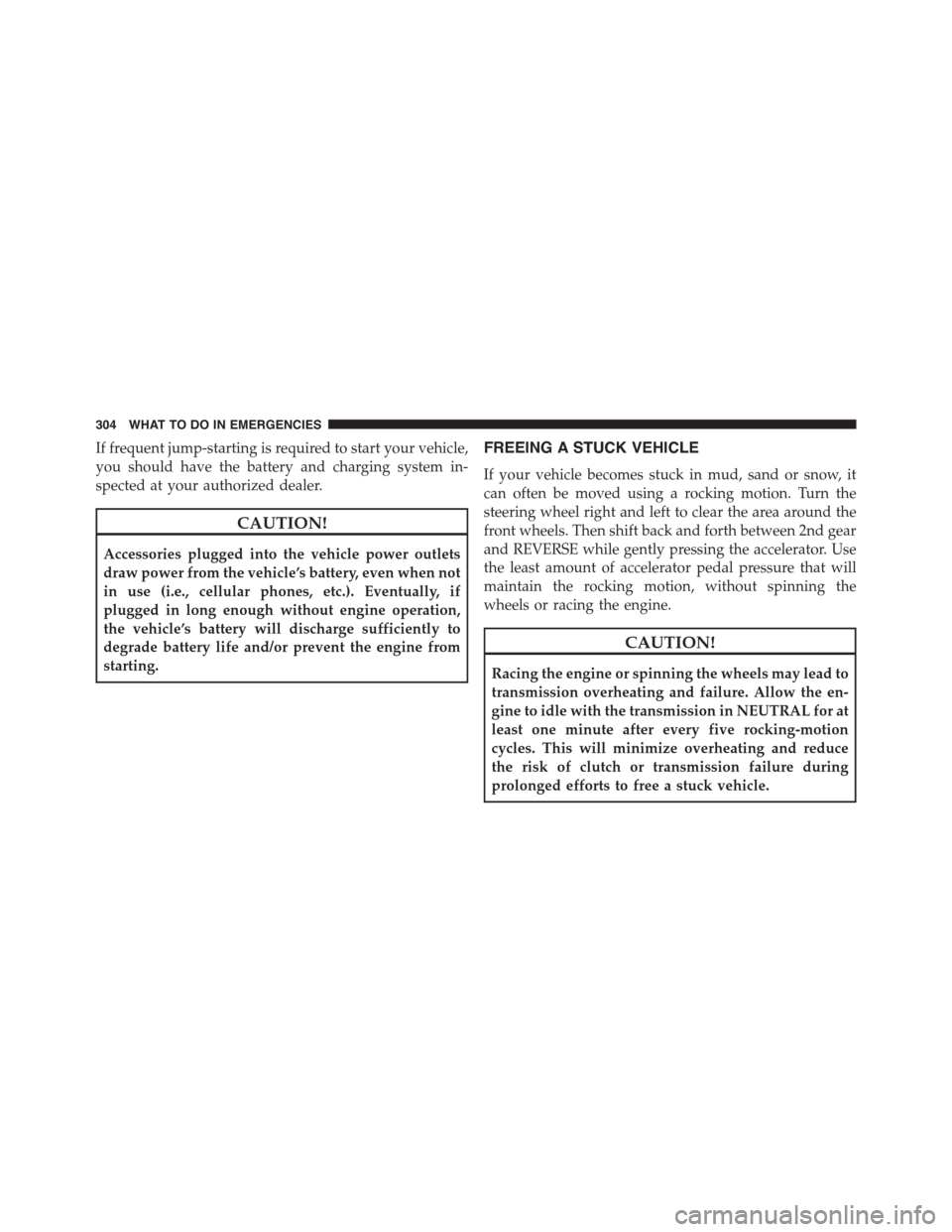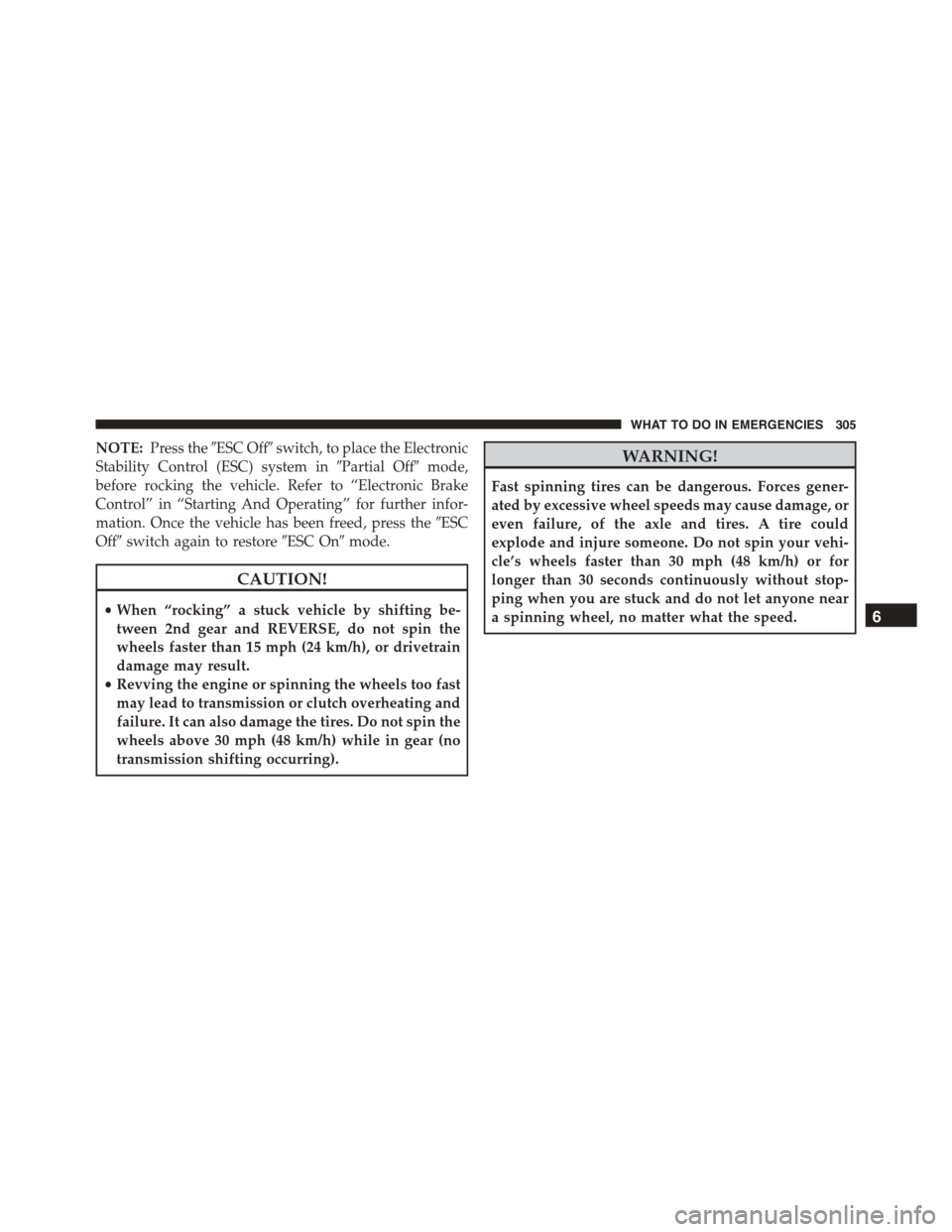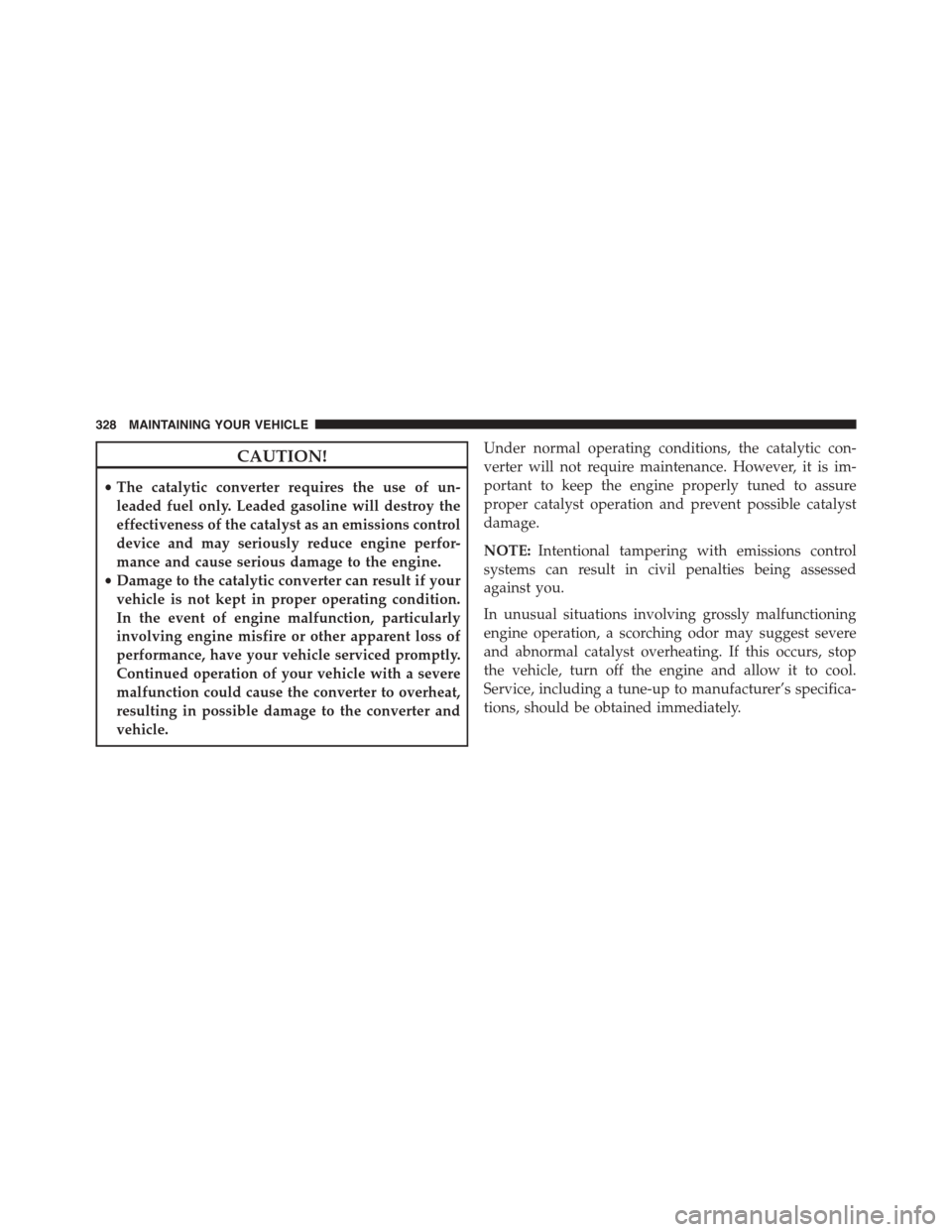2014 FIAT 500 ABARTH overheating
[x] Cancel search: overheatingPage 282 of 392

HAZARD WARNING FLASHERS
The Hazard Warning flasher switch is located on the
instrument panel below the radio.
Press the switch to turn on the Hazard Warning
flashers. When the switch is activated, all direc-
tional turn signals will flash on and off to warn oncoming
traffic of an emergency. Press the switch a second time to
turn off the Hazard Warning flashers.
Do not use this emergency warning system when the
vehicle is in motion. Use it when your vehicle is disabled
and it is creating a safety hazard for other motorists.
If it is necessary to leave the vehicle to go for service, the
Hazard Warning flashers will continue to operate with
the ignition key removed and the vehicle locked.
NOTE:With extended use, the Hazard Warning flashers
may wear down your battery.
IF YOUR ENGINE OVERHEATS
In any of the following situations, you can reduce the
potential for overheating by taking the appropriate ac-
tion.
•On the highways — slow down.
•In city traffic — while stopped, place the transmission
in NEUTRAL, but do not increase engine idle speed.
NOTE:There are steps that you can take to slow down
an impending overheat condition:
•If your air conditioner (A/C) is on, turn it off. The A/C
system adds heat to the engine cooling system and
turning the A/C off can help remove this heat.
•You can also turn the temperature control to maximum
heat, the mode control to floor and the blower control
to high. This allows the heater core to act as a
supplement to the radiator and aids in removing heat
from the engine cooling system.
280 WHAT TO DO IN EMERGENCIES
Page 306 of 392

If frequent jump-starting is required to start your vehicle,
you should have the battery and charging system in-
spected at your authorized dealer.
CAUTION!
Accessories plugged into the vehicle power outlets
draw power from the vehicle’s battery, even when not
in use (i.e., cellular phones, etc.). Eventually, if
plugged in long enough without engine operation,
the vehicle’s battery will discharge sufficiently to
degrade battery life and/or prevent the engine from
starting.
FREEING A STUCK VEHICLE
If your vehicle becomes stuck in mud, sand or snow, it
can often be moved using a rocking motion. Turn the
steering wheel right and left to clear the area around the
front wheels. Then shift back and forth between 2nd gear
and REVERSE while gently pressing the accelerator. Use
the least amount of accelerator pedal pressure that will
maintain the rocking motion, without spinning the
wheels or racing the engine.
CAUTION!
Racing the engine or spinning the wheels may lead to
transmission overheating and failure. Allow the en-
gine to idle with the transmission in NEUTRAL for at
least one minute after every five rocking-motion
cycles. This will minimize overheating and reduce
the risk of clutch or transmission failure during
prolonged efforts to free a stuck vehicle.
304 WHAT TO DO IN EMERGENCIES
Page 307 of 392

NOTE:Press the#ESC Off#switch, to place the Electronic
Stability Control (ESC) system in#Partial Off#mode,
before rocking the vehicle. Refer to “Electronic Brake
Control” in “Starting And Operating” for further infor-
mation. Once the vehicle has been freed, press the#ESC
Off#switch again to restore#ESC On#mode.
CAUTION!
•When “rocking” a stuck vehicle by shifting be-
tween 2nd gear and REVERSE, do not spin the
wheels faster than 15 mph (24 km/h), or drivetrain
damage may result.
•Revving the engine or spinning the wheels too fast
may lead to transmission or clutch overheating and
failure. It can also damage the tires. Do not spin the
wheels above 30 mph (48 km/h) while in gear (no
transmission shifting occurring).
WARNING!
Fast spinning tires can be dangerous. Forces gener-
ated by excessive wheel speeds may cause damage, or
even failure, of the axle and tires. A tire could
explode and injure someone. Do not spin your vehi-
cle’s wheels faster than 30 mph (48 km/h) or for
longer than 30 seconds continuously without stop-
ping when you are stuck and do not let anyone near
a spinning wheel, no matter what the speed.6
WHAT TO DO IN EMERGENCIES 305
Page 330 of 392

CAUTION!
•The catalytic converter requires the use of un-
leaded fuel only. Leaded gasoline will destroy the
effectiveness of the catalyst as an emissions control
device and may seriously reduce engine perfor-
mance and cause serious damage to the engine.
•Damage to the catalytic converter can result if your
vehicle is not kept in proper operating condition.
In the event of engine malfunction, particularly
involving engine misfire or other apparent loss of
performance, have your vehicle serviced promptly.
Continued operation of your vehicle with a severe
malfunction could cause the converter to overheat,
resulting in possible damage to the converter and
vehicle.
Under normal operating conditions, the catalytic con-
verter will not require maintenance. However, it is im-
portant to keep the engine properly tuned to assure
proper catalyst operation and prevent possible catalyst
damage.
NOTE:Intentional tampering with emissions control
systems can result in civil penalties being assessed
against you.
In unusual situations involving grossly malfunctioning
engine operation, a scorching odor may suggest severe
and abnormal catalyst overheating. If this occurs, stop
the vehicle, turn off the engine and allow it to cool.
Service, including a tune-up to manufacturer’s specifica-
tions, should be obtained immediately.
328 MAINTAINING YOUR VEHICLE
Page 381 of 392

Jacking...............................293
Jump Starting..........................300
Towing..............................306
Emission Control System Maintenance..........312
Engine
Air Cleaner...........................318
Break-In Recommendations.................78
Checking Oil Level......................316
Compartment..........................311
Cooling..............................329
Exhaust Gas Caution.....................80
Fails to Start...........................224
Flooded, Starting.......................224
Fuel Requirements......................270
Oil . . . . . . . . . . . . . . . . . . . . . . . . . . . . . . . . ..316
Oil Filler Cap..........................317
Oil Selection...........................317
Overheating...........................280
Starting..............................222
Temperature Gauge......................153
Enhanced Accident Response Feature............51
Event Data Recorder........................56
Exhaust Gas Caution........................26
Exhaust System...........................80
Exterior Lights............................83
Filler Location Fuel........................155
Filters
Air Cleaner...........................318
Air Conditioning.......................321
Engine Oil............................318
Engine Oil Disposal.....................317
Flashers
Turn Signal............................83
Flash-To-Pass............................112
Flooded Engine Starting....................224
Fluid, Brake.............................357
Fluid Capacities..........................356
10
INDEX 379
Page 386 of 392

Recommendation.......................317
Viscosity.............................317
Oil Filter, Selection........................318
Onboard Diagnostic System..................312
Operating Precautions......................312
Operator Manual (Owner’s Manual).............5
Overheating, Engine.......................280
Owner’s Manual (Operator Manual).............5
Paint Care..............................338
Parking Brake............................232
Pets....................................78
Placard, Tire and Loading Information..........250
Power
Door Locks............................22
Mirrors...............................93
Outlet (Auxiliary Electrical Outlet)...........131
Steering..............................230
Sunroof..............................129
Windows..............................23
Power Steering Fluid.......................357
Pregnant Women and Seat Belts................39
Preparation for Jacking.....................295
Radial Ply Tires..........................257
Radio Operation..........................174
Radio Reception..........................174
Radio (Sound Systems).....................174
Rear Liftgate (Sedan).......................25
Rear Window Features.....................138
Recorder, Event Data.......................56
Recreational Towing.......................277
Reformulated Gasoline.....................270
Refrigerant..............................321
Release, Hood............................108
Reminder, Seat Belt.........................37
Remote Keyless Entry (RKE)
FCC General Information..................20
384 INDEX